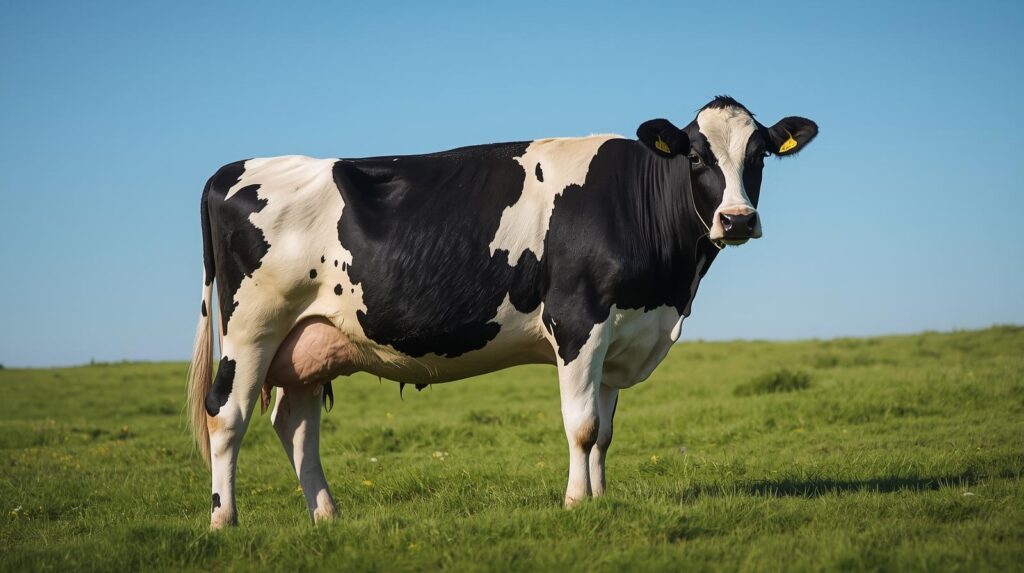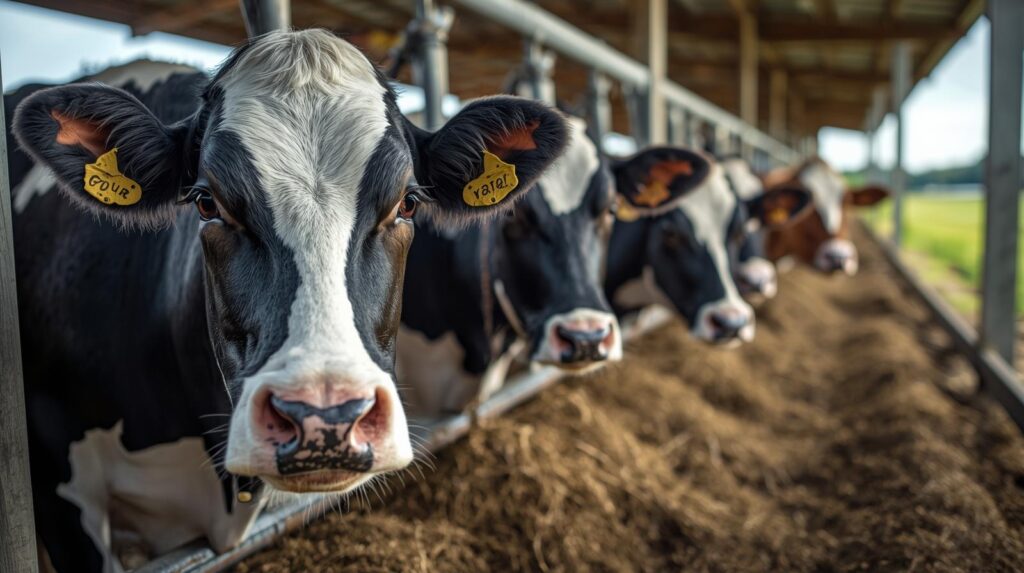Hey, you ever wonder what it takes to keep dairy cows pumping out milk like champs? I’ve got a buddy who runs a small dairy farm, and he’s always tweaking his cows’ diets to boost production. Feeding dairy cows right isn’t just tossing them some hay—it’s a science that can make or break your milk yield. Let’s break it down in a way that’s easy to follow, whether you’re a farmer or just curious.
Good nutrition keeps cows healthy, happy, and productive. A well-fed cow can give you 20–30% more milk, and who doesn’t want that? I’ve seen my friend’s herd go from average to top-notch just by adjusting their feed. Here’s what you need to know to optimize your cows’ diet for max milk output.
Why Nutrition Matters for Milk of Dairy Cows
Cows are like athletes—they need the right fuel to perform. A balanced diet boosts milk yield, improves fat and protein content, and keeps them from getting sick. Poor feed? You’ll see less milk and more vet bills. Studies show well-fed cows produce up to 80 pounds of milk daily, while underfed ones might drop to 50.
Think about it like this: If you skip breakfast, you’re sluggish all day. Cows are the same. My friend learned this when his herd’s output dipped after a bad batch of silage. Lesson? Quality feed equals quality milk.
The Big Three: Energy, Protein, and Fiber
Cows need a mix of energy, protein, and fiber to thrive. Energy comes from carbs like corn or barley—it’s their gas for milk production. Protein, from stuff like soybean meal, builds muscle and milk protein. Fiber, found in hay or silage, keeps their stomachs happy.
For example, my buddy mixes 60% forage (like alfalfa) with 40% grains for his Holsteins. It’s like a smoothie for cows—balanced and easy to digest. Tip: Aim for 18% protein in the diet for lactating cows. Too little, and milk drops; too much, you’re wasting feed.

Forage: The Backbone of the Diet
Forage—like hay, silage, or pasture—is the bulk of a cow’s diet. Good forage means more milk and fewer health issues. Alfalfa’s a favorite because it’s packed with protein and calcium. Corn silage is great for energy but needs balancing with protein sources.
I visited a farm where they switched to high-quality alfalfa, and milk jumped by 5 pounds per cow daily. Chop forage finely to help digestion, but don’t overdo it—cows need some bulk to chew. Warning: Moldy or low-nutrient forage can tank production, so test your feed regularly.
Concentrates: Power Up the Milk
Concentrates, like grains or soybean meal, are the extra kick for milk production. They’re high-energy and protein-packed but pricey, so use them wisely. A common mix is corn, barley, and soybean meal—think of it as a cow’s protein shake.
My friend feeds about 15 pounds of concentrates daily per cow, adjusted for milk output. Overfeeding can cause acidosis, where the stomach gets too acidic, so watch for signs like loose manure. Pro tip: Split concentrates into two or three feedings to keep digestion smooth.
Minerals and Vitamins: Small but Mighty
Don’t skip the little stuff. Calcium, phosphorus, and magnesium are key for milk and cow health. Vitamins A, D, and E support immunity and reproduction. Most farmers add a mineral mix to feed—costs about $20 per ton of feed.
I saw a herd struggle with low calcium—cows were shaky after calving. A quick tweak to their mineral mix fixed it. Tip: Blood or milk tests can spot deficiencies. FAQ: Can I skip minerals? Nope, even small shortages can cut milk or cause health issues.
Water: The Unsung Hero
Cows drink a ton—up to 30 gallons a day when lactating. Clean, fresh water is non-negotiable. Skimp on it, and milk drops fast. My buddy installed extra water troughs, and his cows’ output climbed 3%.
Keep troughs clean—algae or dirt can make cows drink less. In hot weather, they need even more. Real-life win: A farm near me added chilled water tanks, and production held steady during a heatwave. Check water quality yearly; bad water messes with everything.
Feeding for Stages: Match the Diet to the Dairy Cows
Cows have different needs depending on their stage—early lactation, mid-lactation, or dry period. Early lactation (first 100 days after calving) is when they’re milk machines. Feed them 20% more energy and protein to keep up.
Dry cows need less energy but more fiber to prep for calving. My friend messed this up once, overfeeding dry cows, and they had calving issues. Now he uses a “transition diet” with extra hay. Tip: Work with a nutritionist to tweak diets per stage—it’s worth the $100 consult.

Using Tech to Fine-Tune Diets
Tech’s changing the game. Feed management software, like DairyComp, tracks what each cow eats and how much milk she gives. Some farms use sensors to monitor chewing—less chewing means digestion issues. These tools can cost $500–$2,000 but pay off in higher yields.
My buddy uses a basic app to log feed mixes. It caught a protein dip before it hit milk output. Telehealth for cows is also a thing—vets check diet plans via video, saving a trip. Warning: Don’t rely only on tech; walk the barn and watch your cows.
Common Mistakes to Avoid
It’s easy to mess up. Overfeeding concentrates can cause bloat or acidosis. Underfeeding forage leads to low milk fat. Switching feeds too fast? That’s a recipe for upset stomachs. My friend once changed silage brands overnight—cows went off feed for days.
Stick to gradual changes over a week. Test feed quality—$50 for a lab test beats losing $500 in milk. And don’t ignore cow behavior. If they’re not eating eagerly, something’s off—check the feed or call a vet.
Telehealth: Your Nutrition Sidekick
Speaking of vets, telehealth is a lifesaver for diet tweaks. Apps like HerdWatch let you share feed plans or cow symptoms with a nutritionist remotely. A quick $30 video call can spot issues like low protein or bad silage.
I know a farmer who used telehealth to fix a milk fat drop. The vet suggested more fiber via chat, and it worked in a week. It’s great for small farms without a full-time nutritionist. FAQ: Can telehealth replace farm visits? Not fully, but it’s awesome for quick checks.
Practical Tips for Your Farm
Start simple: Test your forage and water quality. Mix feeds to hit 18% protein and 30% fiber for lactating cows. Use a scale to measure concentrates—guessing wastes money. My buddy keeps a notebook for each cow’s diet changes; it’s old-school but works.
Invest in a $100 mineral mix tailored to your herd. Split feedings to avoid stomach issues. And talk to your cows—they’ll “tell” you if the diet’s off by eating less or looking sluggish. Benefit: A good diet cuts vet bills and boosts milk by 10–20%.
FAQs: Quick Answers for Farmers
How do I know if my feed’s balanced?
Test it at a lab and watch milk output—low fat or protein means something’s off.
Can I feed only pasture?
It’s tough—pasture alone often lacks energy for high milk yields. Supplement with concentrates.
What’s the best forage?
Alfalfa or corn silage, but test for nutrients. Quality beats quantity.
How much feed per cow?
About 50 pounds daily for a lactating Holstein, split into forage and concentrates.
Is organic feed worth it?
It depends—organic can work if nutrient levels match, but it’s pricier.
Wrapping It Up: Feed Smart, Milk More
Feeding dairy cows right is like tuning a car—you get better performance and fewer breakdowns. Focus on quality forage, balanced concentrates, and clean water. Use tech or telehealth to stay on track, and don’t skip the little stuff like minerals.
Try one change this week—maybe test your silage or add a water trough. Your cows will thank you with more milk, and your wallet will too. What’s your first step to better cow nutrition?
